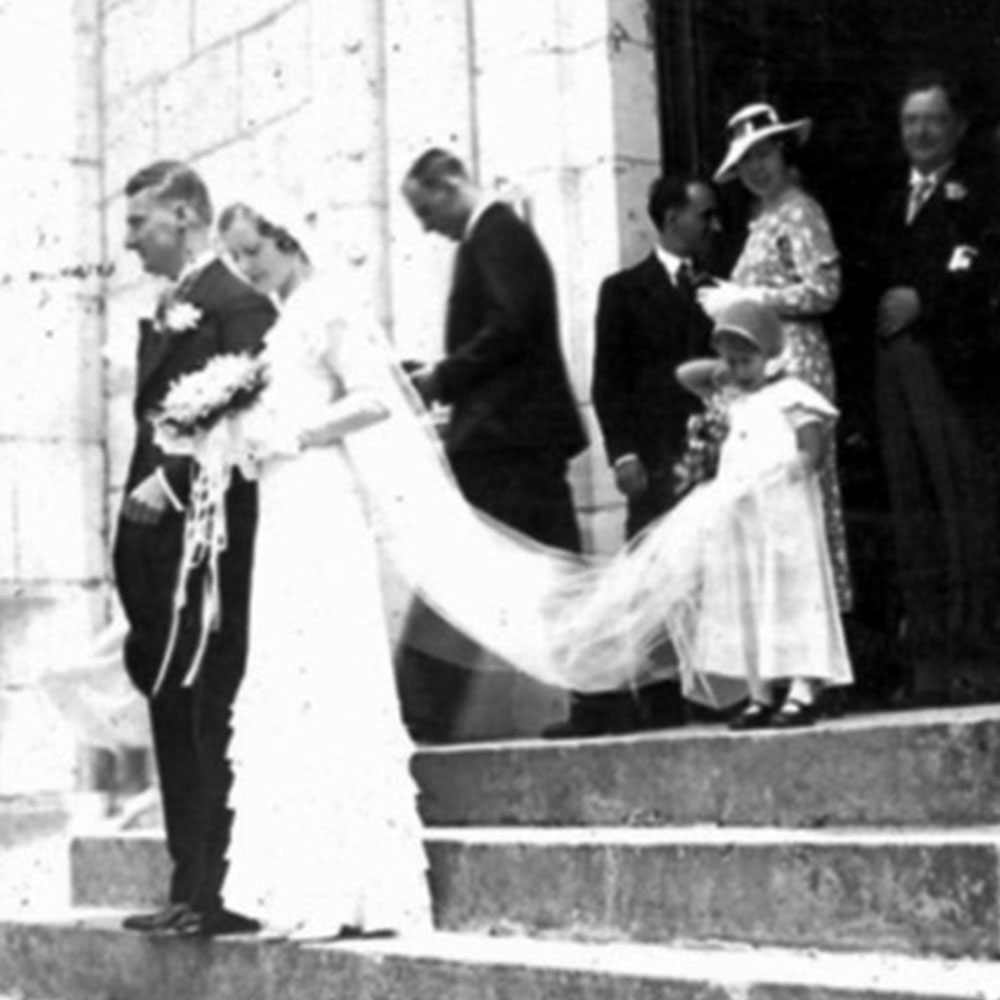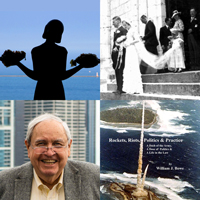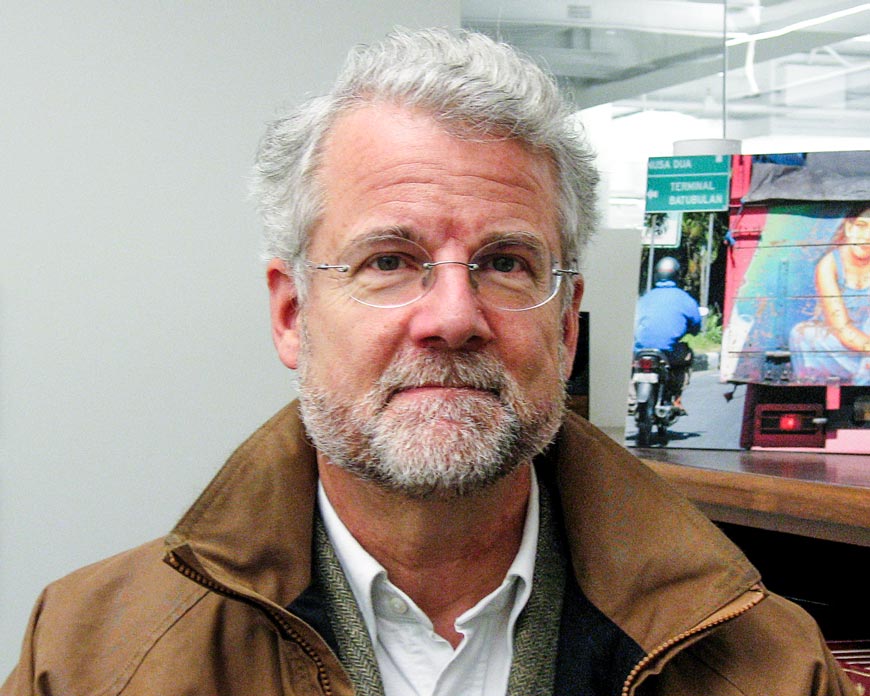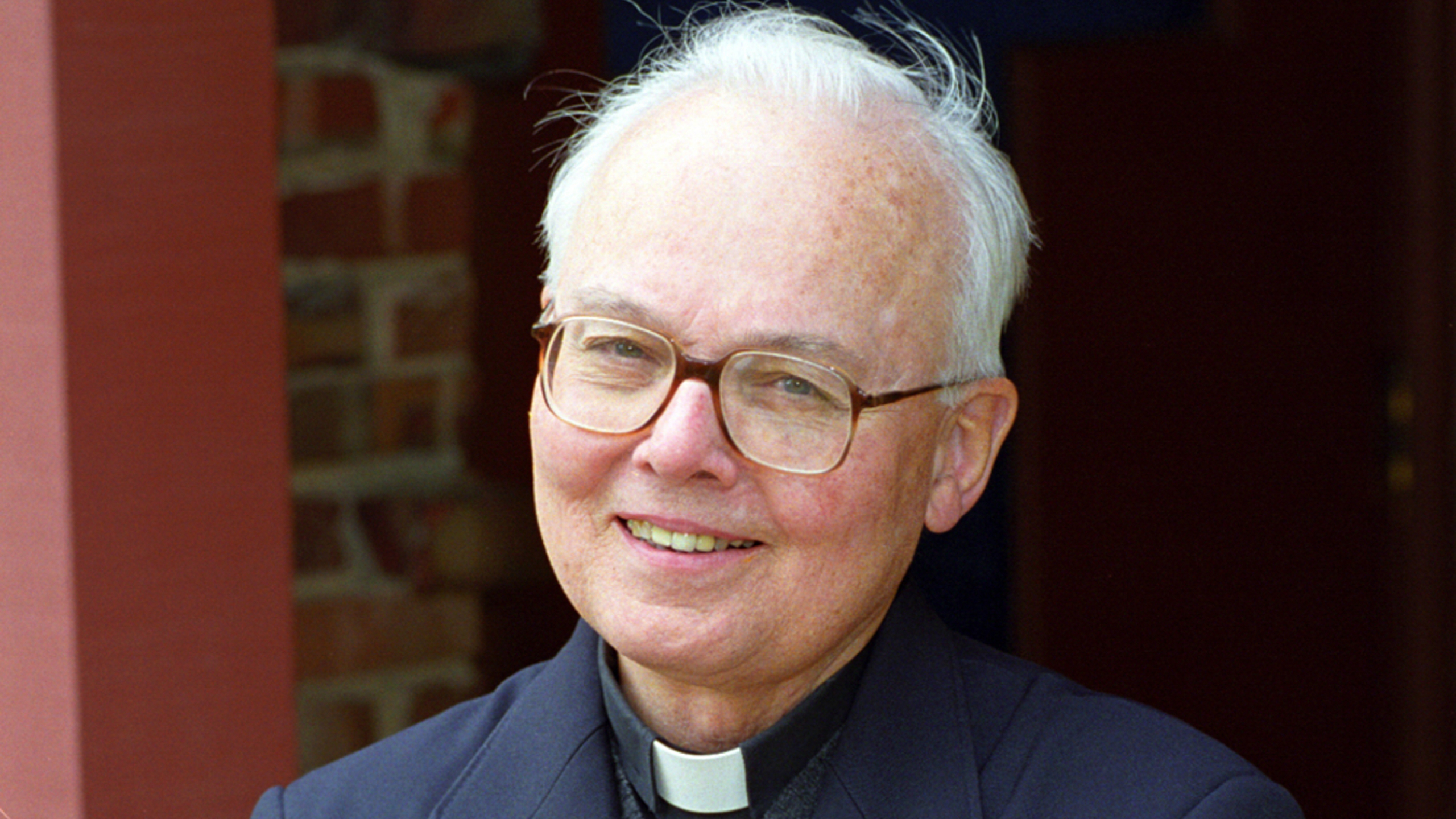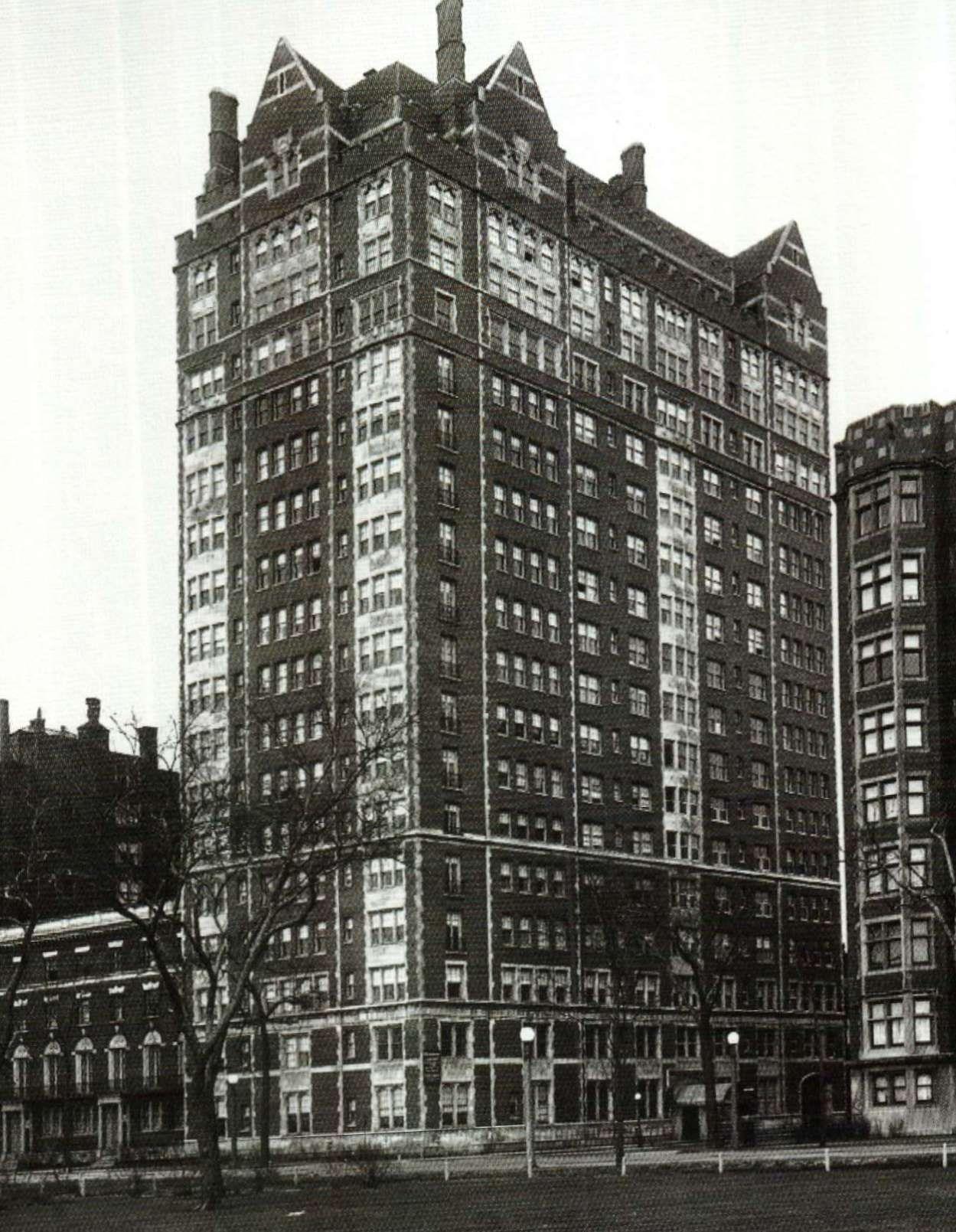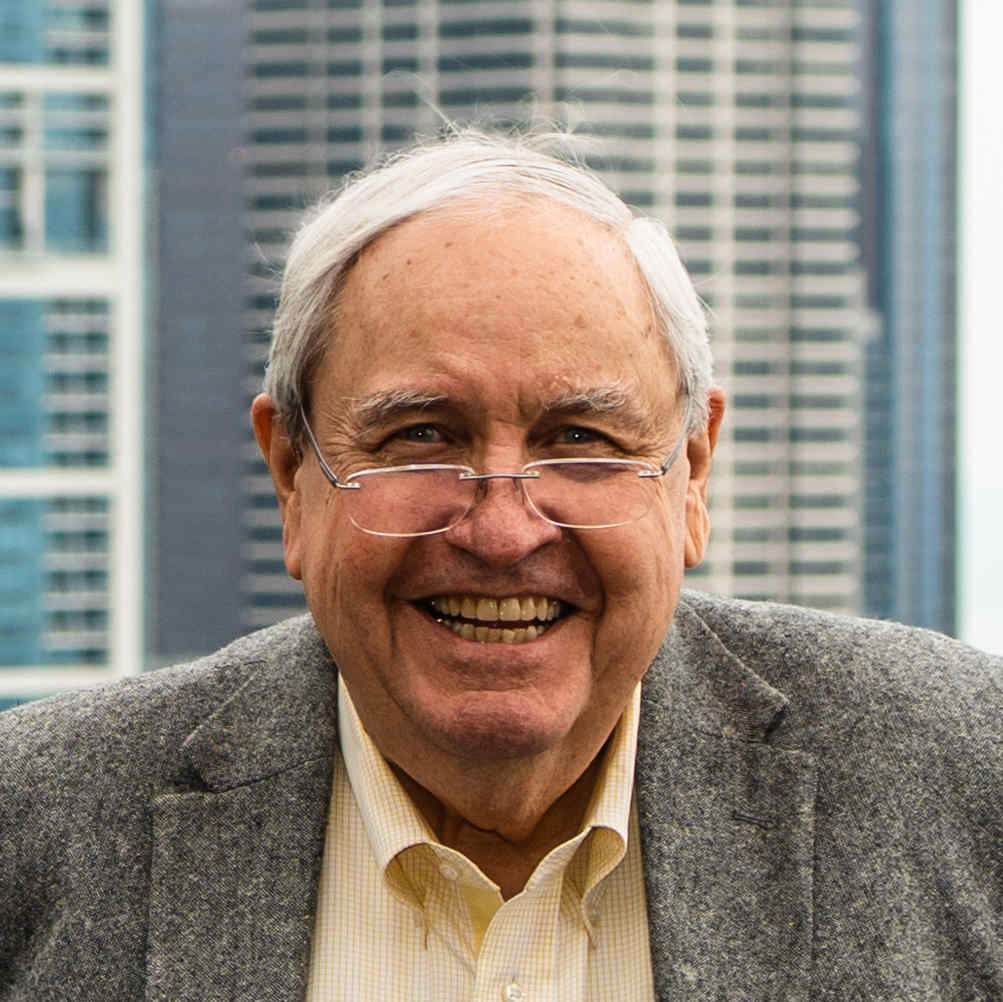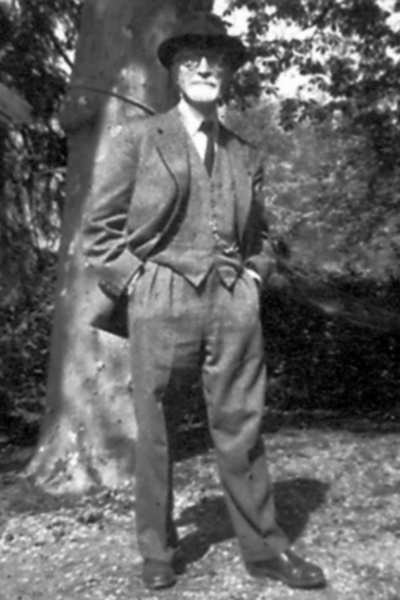
Paul Riboud (1872-1972)
Chindrieux, France in 1949
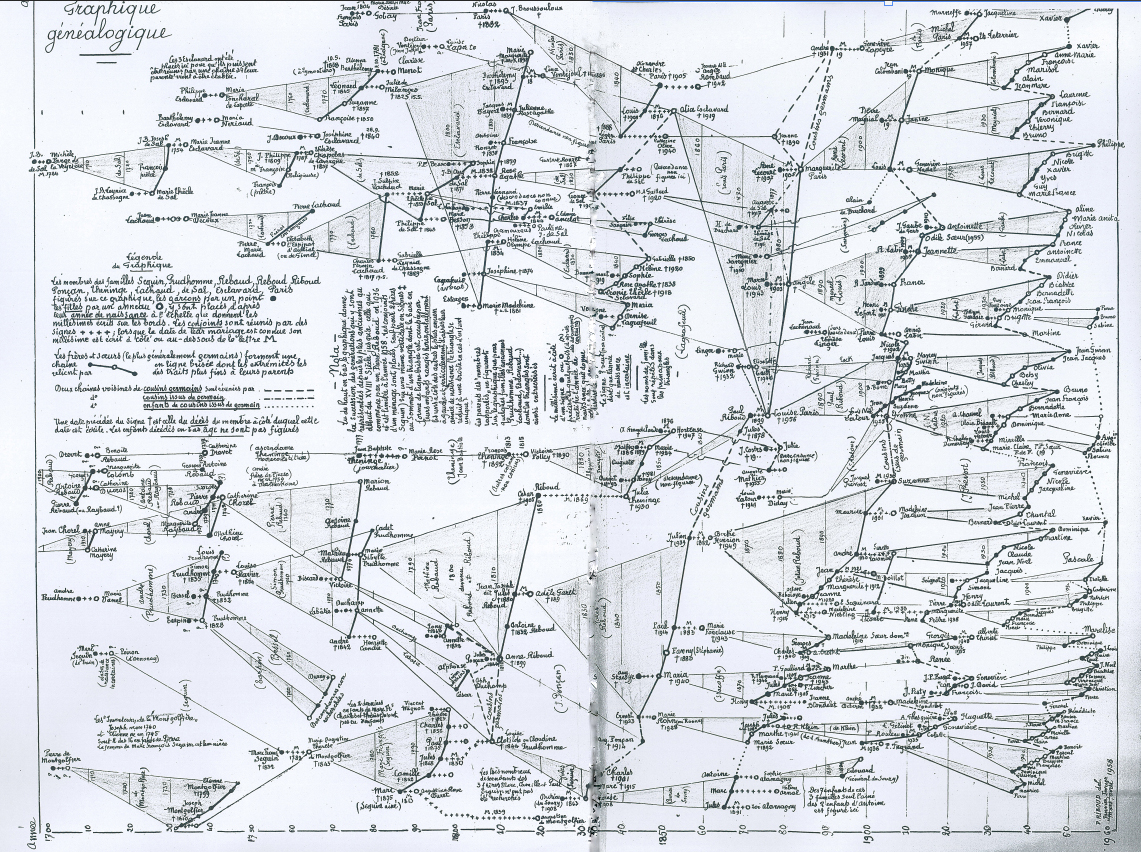
Graphique Genealogique
The Family Genealogy Tree Drawn by Paul Riboud
Editor’s Note: Paul Riboud, who lived to be 100, graduated in 1891 with honors from France’s most prestigious university, Ecole Polytechnique. He was trained there as a civil engineer and went on to both a successful career and personal life. Both of these aspects of his life were filled with exceptional challenges, triumphs and tragedies. His later years, when I had a chance to meet him, entailed a rich family life, but along the way some of his closest family members had predeceased him. In his work, he rose to enormous responsibilities in France as Director General of the France’s Railways of the East (Directeur Général des Chemins de Fer de l’Est).
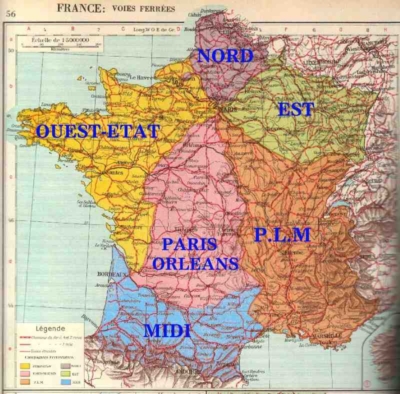
And in his working life, he also endured the painful Lagny train wreck that occurred on his watch in 1933. The accident killed 204 passengers and injured 120. One of the histories records the scene:
Lagny, France 23 December 1933. The Paris – Strasbourg Express 25 bis left Paris close behind the Paris – Nancy train which had been severely delayed due to the foggy conditions that prevailed that evening. Near Lagny, about 17 miles (23Km) from Paris, the Strasbourg express having overun signals, ploughed into the rear of the Nancy train. The resulting carnage was one of France’s worst rail disasters. Signals had been set to protect the Nancy train. A combination of darkness, fog and signals that were only dimly lit by oil lamps made it difficult for drivers to spot which aspect was being displayed. Neither the tractionaire (driver) Daubigny nor his fireman Charpentier seem to have noticed that caution signals and a danger signal were set against them.
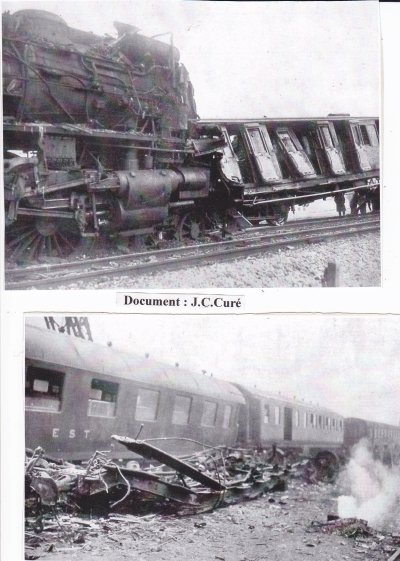
Eulogy for Bon-Papa
Introduction to
Albert Caquot’s
Eulogy for Paul Riboud
Jean-François Latour writing on May 24, 2012 to members of the Latour and Riboud families:
This is about our common grandfather, Paul Riboud:
Having celebrated the fiftieth anniversary of my graduation from the school a few days ago[1], I had the opportunity to contact the magnificent library of the School at Palaiseau. I gave them some books inherited from Bon-Papa, notably the Astronomy and Geodesy[2] books. In the margins were Bon-Papa’s annotations. This greatly interested the archivist as a testament to how the course was received!
I also gave him a very nice book published in 1894 on the occasion of the centenary of the founding of the School. This book has many pretty prints and tells of school life and traditions. It also contains biographies of many illustrious alumni.
But this very bulky book was in bad shape, and I thought it would be better in a place where it would be restored and enhanced.
A graphic on the first page had “Ex-Libris Riboud.” It was an ex-libris with the R and the owl. This greatly amused the archivist. He will keep it with a reference indicating that these books belonged to Paul Riboud, together with a biographical note about him.
The archivist confirmed to us that he is very interested in documents on the school’s early alumni (the “ancients”), such as books, letters[1], photos and the like provided by their families. He said all of this was easily accessible regarding earlier graduates, but were not so available for recent alumni.
He showed us the competition register of 1891 where we could see the notes of Paul Riboud, who had extra recognition because he also had a literary baccalaureate. Paul’s grades over the two years of school developed spectacularly:
Entry: 264 °; Rank 1st;
First Semester of First Year, Rank 35th;
End of First Year, Rank 10th; and
End of Second Year, Rank 15th.
The archivist also gave us a copy of the superb speech given in 1935 by Bon-Papa when he gave his friend Albert Caquot his Academician of Science sword. The copy is not very readable, and I did not attach it, but I did put below the article by Albert Caquot. It appeared in the journal of the school (La Jaune et La Rouge) in March, 1973. Since it was written only a few months after Bon-Papa’s death, you will surely learn something new about our grandfather.
Footnotes:
[1] “The Maison Latour house had sponsored the event by providing a wine with lunch. In the little speech I gave on this occasion, I recalled that the Latour house (1797) was almost contemporary with the school (1794), and that the Latour House was located in Beaune, home of Gaspard Monge!”
The school referred to is the French Ministry of Defense Engineering School originally located in Paris, but since 1976 in Palaiseau, France. Gaspard Monge was a mathematician, expert in mechanical and architectural drawing, and a founder of the school. According to Encyclopaedia Britannica:
École Polytechnique, (French: “Polytechnic School”) was established in 1794 by the National Convention as the École Centrale des Travaux Publics (“Central School of Public Works”) under the leadership of Lazare Carnot and Gaspard Monge. It took its present name in 1795 and absorbed the state artillery school in 1802. Originally under the direction of the Ministry of the Interior, it was transformed into a military school by Napoleon (1804). In the past, most graduates became technical officers in the military forces; today most go into government service or business. There are faculties of mathematics, mechanical engineering, physics, chemistry, economics, and humanities and social sciences.
Gaspard Monge, count de Péluse, (born May 10, 1746, Beaune, France—died July 28, 1818, Paris), French mathematician who invented descriptive geometry, the study of the mathematical principles of representing three-dimensional objects in a two-dimensional plane; no longer an active discipline in mathematics, the subject is part of mechanical and architectural drawing. He was a prominent figure during the French Revolution, helping to establish the metric system and the École Polytechnique. He was made a count in 1808 by Napoleon I. Monge was educated at the Oratorian schools at Beaune and at Lyon, where for a time at age 16 he was a physics teacher. He made a large-scale plan of Beaune during a visit in 1762, devising methods of observation and constructing the necessary surveying instruments. Impressed with the plan, a military officer recommended Monge to the commandant of the aristocratic military school of Mézières, where he was accepted as a draftsman.
“Geodesy” according to the definition in Merriam-Webster’s Collegiate Dictionary is:
a branch of applied mathematics concerned with the determination of the size and shape of the earth and the exact positions of points on its surface and with the description of variations of its gravity field.
About Albert Caquot
The Eulogist of Paul Riboud
Editor’s Note: Albert Caquot (1881-1886) wrote the eulogy of Paul Riboud that appears below. It was first published shortly after Paul Riboud’s death in the March 1973 issue of Ecole Polytechnique’s journal, The Yellow and the Red, In addition to being Paul Riboud’s friend he was also a graduate of Ecole Polytechnique, a world class engineer, and broad minded visionary. This short biographical note about Caquot appeared in a book review recalling his life and published in the October, 2001 issue of The Yellow and the Red. Among Caquot’s own ingenious engineering feats was designing an original dam on the Brittany coast of the English Channel at Saint-Malo. It was an engineering project built for Climate Change before we even knew about Climate Change. Encyclopaedia Britannica describes this work as “the world’s first large-scale tidal plant using flood and ebb tides to generate electricity.”
Time continues to shed additional light on the work of Albert Caquot (X 1899). This great scholar was one of the most influential of his century and one of the most enlightened minds of his time. There are researchers who have only one string to their bow; such was not the case. What does a tail balloon, a tidal power plant, a cable-stayed bridge or a caquoid have in common? All these inventions were the work of this great engineer, whose talent was successfully exercised in many fields.
A skilled designer, tireless calculator, Albert Caquot also knew how to discern the path of forces in matter in order to discipline them, also passing easily from aerodynamics to hydrodynamics. It was to the latter area that he devoted the end of his life, developing his thoughts as a visionary.
This book is also the witness of most of the past century. Real desire for young intelligences from a modest background to rise in society. Dedication of the masters of instruction. The first aerial flights and the primacy of the lighter-than-air in land and sea battles. Indomitable patriotism during the First World War. In line with the works of the Universal Exhibitions, popular enthusiasm still manifested for several decades towards major civil engineering works.
And also, European rivalries, carelessness of our finances, ruinous devaluations, weakness of our foreign exchange reserves with the absolute necessity of exploiting all the renewable energy sites… Yes, Albert Caquot’s life is inscribed on this backdrop, the backdrop of the twentieth century of which it follows all the contours.
Through the description of the life and work of this extraordinary character, this book sheds light on a whole section of the history of the 20th century, a story full of richness and passion.
A Great Engineer: Paul Riboud (Class of 1891)
By Albert Caquot (Class of 1899)
Member of the Academy of Sciences
Our dean, an eminent servant of France, has left us in his hundredth year.
He had retained this remarkable demeanor of a man whose wisdom controls all actions and is interested in all elements of life.
The last time we talked, we discussed the current problems of Western nations, and the solutions that could be foreseen.
Paul Riboud was born on boulevard Voltaire in Paris, on December 16,1872. His father, a PL.M. employee, carefully watched with his mother over his education and instruction, which began in the small private school next door. Then, with the advice of his school principal, to whom he had spontaneously given German lessons, he was able to enter the Charlemagne School on a half-scholarship in 1882. He had a brother three years older who died of croup in 1878, which distressed him a great deal.
This period, after the unhappy war of 1870, is characterized by the reaction of all French people, even modest ones, to help the nation free itself from its war debt. The general public mood was far from the utopian conception of the welfare state.
He entered Ecole Polytechnique at the top of the first year class. He was particularly grateful to Edouard Lucas, his teacher in the classes dealing with road construction.
His three years in Versailles at the School of Application allowed him to live near his parents, but in 1897 he was appointed to a post in charge of an group of national and local roads. He moved away from Versailles to establish his own home, but then had the misfortune of losing his young wife and the expected child.
At his request, he was appointed in 1901 to an important post dealing with local roads and railroads under the management of the Chief Engineer Limasset, the navigation of the Aisne River under the command of Chief Engineer Bourgin in Reims, and the navigation of Oise River, which was under Chief Engineer Duzusea in Compiegne.
He was able to start a new home with a remarkable young woman, Mademoiselle Louise Paris, who was a wonderful companion throughout her active life.
His career in Soissons was brilliant, much loved by his chiefs for the quality of his construction and rigorous punctuality. He was working a lot, visiting the sites, administering its three departments, and checking out or doing the long calculations of the structures. This is how the projects were carried out for these railways of local engineering works.
These included the new technique of reinforced concrete, the bias bridge of Soissons, and other bridges at Pontavert and de Guignicourt, and the Château-Thierry Bridge. The latter was remarkable for the low curvature of its arcs in spite of its force loads, as well as its moderate price. Destroyed in the center of the Battle of the Marne, it was rebuilt using the same drawings. These projects served the labor intensive sugar beet region of Soissons.
After President Combes had imitated Louis XIV for the French people, during election time, local newspapers in all the constituencies competed with each other using biased and false reporting. Railways under construction were a topic of interest to readers, so engineers were basely slandered.
The CLA Director of Personnel Veille, despite his political nature, had particular esteem for the high moral and professional Paul Riboud, and he offered new positions to this brilliant engineer.
The latter headed for the eastern network, on the advice of Chief Duzuseau, who introduced him to the eminent engineer des-‘Cubes. They understood each other at the first interview, and Paul Riboud was immediately taken out of his prior responsibilities.
On October 16, 1908, he became Principal Engineer. He was placed at the head of the railway district of Troyes, where he made the acquaintance of the engineer responsible for all the railway bridges in the Aube department.
I knew his reputation from those of my classmates having been on mission in Soissons, and our acquaintance became a deep friendship when the disaster of 1910, affected our services. In January, with no flood forecast, Troyes, located too far upstream in the valley for the design of this period, had its dikes surmounted and several neighborhoods flooded. Five of the seven railway lines using its station were completely cut off.
In the main bed of the dam, the discharge structures had no deep foundations and had crumbled. Even an important work of art on the minor bed, such as the Arso val-Jaucourt bridge on the railway line from Paris to Belfort, was destroyed.
Paul Riboud proved to be an exceptional director in the disaster recovery effort. All rail and road circulation was restored in a few weeks by implementing either direct repairs or temporary aprons. And this was all done with a remarkable economy.
Then, when the most important arrondissement in France, that of Paris, became available with the retirement of Engineer Muntz, Paul Riboud was appointed Chief of the district in September of the same year 1910.
He was a tireless worker, being at his desk one hour before the office opened and being the last to leave, and he gave a strong push to all railroad track modernization efforts.
On February 16, 1914, he was appointed Deputy Chief Engineer of the railroad. This network was the remarkable tool which had allowed General Joffre to quickly regroup the French armies in World War I and it allowed the victory of the Marne.
Paul Riboud ensured steady railway service for the region. As manager he was also in charge of coordination with the Thur valley recovery effort in Alsace, as well as liaison work with military engineers responsible for the strategic rail lines, station management and the design and repair works of art. He inspired dedication and respect through his hard work and efficiency.
On April 21, 1915, he was made Knight of the Legion of Honor.
On May 15, 1919, the Director of the Network, Gerardin, made him his deputy and, when he retired in 1921, proposed to the Network Council that Paul Riboud be his successor.
The successive Presidents, Gomel, Renaudin, and Marlio, all appreciated Paul Riboud’s knowledge, high consciousness, total independence, and the new Director’s rigorous sense of social justice.
The Eastern railroad network, strongly structured, with a lean management, was alone during this period to in making contributions to the national finances as well as other rail networks. Simultaneously, Paul Riboud was providing his railway workers with important benefits. On June 11, 1931, the model house of Séricourt was inaugurated for treatment of employees suffering from tuberculosis. Continued devaluation and the economic dislocations created by Parliament no longer allowed for the necessary housing for the new generation. Yet Paul Riboud built 39 towns for railway workers, most of them with social services.
France owes him a debt for having foreseen the importance of communications and the country’s industrialization. He understood ahead of others what was economically valid and necessary.
His attention focused on France’s eastern border when Hitler published Mein Kampf and the Nazis gradually took power.
He doubled the size of the Gare de l’Est and all of its tracks and it is the only train station in Paris that has been able to meet the demand for since that time. This magnificent achievement, inaugurated in December 1931, was made possible by Chief Engineer Descubes. It was he who had welcomed Paul Riboud and had had the greatest confidence in his engineering skills and the decency and moral standards of this eminent builder.
In 1930, suffering from a retina problem, Paul Riboud offered his resignation. It was refused by the Network Council. Despite the embarrassment and suffering, his willpower overcame the hardships and he continued his leadership until August 1, 1935, when this time President Marlio finally accepted his retirement.
It is not without emotion that we reread the deliberation of the Network Council of the Company of where the two Presidents Renaudin and Marlio thanked their Director and conferred on him honorary status.
Family trials were not spared him. He then had the misfortune to accidentally lose Nicole, his third child, a sweet and beautiful young girl.
High intelligence, great authority, total personal modesty, such is what I remember and keep in mind when I think of my incomparable friend that we have just lost.
To recall the milieu of the East Company then, I refer to the testimony of two ministers of public works. Roy, who ranked the East first of all the networks, and my friend Monzie. He said of Paul Riboud, with his great spirit of finesse, that he was a moral plumb line.
A Commander of the Legion of Honor, Paul Riboud was also honored with numerous foreign awards.
During his 27 years spent in the Eastern network, he had lived intensely through three catastrophes: the flood of January, 1910, the war of 1914-1918, and the terrible accident at Lagny in December, 1933. The latter had particularly affected him as he had paid constant attention to improvement of security.
Paul Riboud was also interested in any national effort. When in 1921, under the presidency of Marshal Liautey, we wanted to save the future of aviation. The economic policies of the government and laws of parliament had by then rendered it moribund. Despite its magnificent role in our World War I victory, great French people like General Marchand (the hero of Fachoda), Edouard Michelin, Javary and Paul Riboud needed to awaken public opinion. And some people responded to this call.
To make aviation active, they thought of a commercial network and created a company, SODAC, entrusting its presidency to Paul Riboud. At the time, he couldn’t get deliveries from the Post Office and the Ministry of Control of the railway networks hampered any serious effort. Thus, SODAC could not develop the essential structure of the aerodrome network it was studying and in 1933 the company had to dissolve.
The highly contested the politics of France between the two wars led us directly, by lack of preparation and lack of understanding, to the disaster of 1940.
Paul Riboud remained very active after his retirement. At the request of Raoul Dautry, he directed a general review of the railroad routes in preparation for necessary progress over the next twenty years. His review set a high standard and each part of his analysis is a teaching marked by the precision of its presentation and the logic of its solution.
He left us on September 25, 1972, in Aloxe-Corton (Côte-d’Or). He was with his children, in his hundredth year, and rests in Chindrieux (Savoie) near the house he had built for all his family.
We can only offer to his children, Mr. and Mrs. Louis-Noël Latour, Mr. and Mrs. Jacques Riboud, to their many children and grandchildren, our veneration and profound sorrow in the fond memory of this great Frenchman.
Albert Caquot
Olivia Riboud Recalls Her Parents and Grandparents
Editor’s Note: In the spring of 2023, I had this conversation with my first cousin, Olivia Cosgrave Riboud, always known to me as Livie. Livie is the daughter of my mother’s sister, Nancy Gwinn Riboud, and the closest to me in age of my French cousins. Both of us have always shared an interest in our family histories, so it was fun for us to have a chance to chat together as usual about the Gwinn Family and Riboud Family.
Our conversation began with a brief exchange on the importance our parents’ generation attached to family bonds. The relationships between the Bowe Families and the Riboud families would never have survived separation by the Atlantic Ocean over four generations without these values being deeply embedded in Livie and me as we grew up. As a first observation, Livie notes that her father, Jacques Riboud, was more voluble in talking about family history than her mother. She notes with regret that some of the family information from her mother she carefully wrote down was lost when she later lost track of her notepad. Next, Livie briefly went on to review her siblings, Chesley, Betsy, Jean Jacques, and Jean Gwinn Riboud and their de la Chapelle, Lacombe, Kuhn, and Corderoc’h offspring.
Livie’s mother, “Nancy” Anne Chesley Gwinn, was born in Baltimore, Maryland in 1911 to her parents, Richard Gwinn, Jr., my maternal grandfather, and his second wife, Elizabeth Tack Gwinn. Livie talks about her mother Nancy Gwinn’s sisters, Elizabeth Gwinn, known as Betty, and Martha Gwinn, who later married John Casey. Nancy, Martha and Betty’s oldest sister was Mary Gwinn Bowe, my mother. My mother’s mother was Richard Gwinn’s first wife, Mary Roche Gwinn. She had died in 1901 giving birth to my mother. Livie says her mother Nancy said, speaking of the way she and her sisters thought of their father, Richard Gwinn, “We were all crazy about him.” Livie remembers my mother, her Aunt Mary Gwinn Bowe, as a “grand lady,” and my father William Bowe, Sr. as “extremely charming,” but probably a “difficult” father. Pictures of Jacques Riboud when he married Nancy Gwinn in 1933 confirm Livie statement that her mother married a “sexy Frenchman.”
Livie says Jacques’ father, Paul Riboud (“Bon Papa”), was “brilliant.” She reviews how he entered the great French engineering school Ecole Polytechnique as the last in his class, but finished first. Coming from a modest family in the Lyon area, she reports that Bon Papa was the son of a railroad man, but Bon Papa’s railroad career was different in that he was wildly successful as he went on to become director of the entire Eastern Division of the French railway system. Along the way, Bon Papa had suffered a devastating loss when his first wife died in childbirth. Livie says he had another terrible event in his life when a train accident in Lagne, France killing many passengers happened on his watch. Livie says that Bon Papa’s second wife, Livie’s French grandmother, Louise Paris Riboud, was an artistic woman who was born in the Auvergne region of France. Livie says was a good painter, and she tells the family story of pinch-penny Bon Papa reluctantly paying a 1,000 francs for a watercolor painting Louise fancied.
Livie goes on to talk about the tragic, not so accidental, death of Bon Papa and Louise’s daughter Nicole Riboud in Chindrieux, France in 1942, the year I was born. Livie explains the painful way Bon Papa dealt with the event’s aftermath in the small village during the pressures of World War II. Before the War, Nicole, who spoke English, had visited the Bowe family in Chicago and I have a picture of her by Lake Michigan near our apartment. Both Livie and I went on to recall the image of Bon Papa driving his small, almost antique Citroen car as he approached 100 years of age. Livie says that Bon Papa had a more intimate relationship with his daughter Yvonne Riboud Latour than he had with his son Jacques. She reports the latter relationship focused more on business and politics than family matters. Speaking again of her father Jacques, Livie says that he had a wonderful relationship with his sister Yvonne and that at the dinner table, they could be the “funniest couple in the world.”
Livie explains how the French Riboud family became intertwined with the American Gwinn family when Jacques and Nancy met each other in 1932 while both were crossing the Atlantic on the ocean liner Lafayette, the largest ship of the French Line service. She says that members of the Gwinn family had become intimately familiar with Europe earlier. Betty had studied voice in Germany in the 1920s with pianist Artur Schnabel’s wife, contralto and Lieder singer Therese Behr Schnabel and Martha had separately pursued classical music training there with her piano studies. Both Livie and I struggled to remember exactly how Martha and concert pianist Rudolf Serkin came to be good friends in this period. I recall as a boy in the 1950s when Martha and her husband John Casey and Serkin visited our Elm Street apartment once when Serkin visited Chicago to give a concert at Ravinia. Livie says that her mother Nancy had shown some artistic talent as a young dancer, but shortly found pursuing this art form was was deemed unbecoming because, “young girls don’t show their legs.” While not pursuing her dance bent further, Livie reports her mother had other artistic interests and had come to know opera singer Jessye Norman through Agatha Moll, a
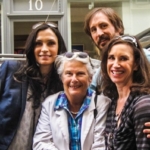
Livie Riboud & Mary Frates with Cole Frates & Famke Janssen
friend of her sister Martha. If the Gwinn family had become Europeanized, Jacques Riboud had become somewhat Americanized through an exceptional visit to the United States.
This was in the period immediately preceding his return to France on the Lafayette. As a young Frenchman interested in learning about the oil business, he had come to the States on a Grand Tour to visit the main outposts of its booming oil sector. On his trip to understand this newly developing industry, Jacques had made a stop in the boomtown of Punca City, Oklahoma, where he visited the home of oil tycoon E.W. Marland. Livie reports how Marland hosted the young man in now famous Marland Mansion there. Livie also notes the amazing coincidence that at one grand party in Oklahoma attended by her father, he had danced with mother of one of Livie’s lifelong friends, Mary Frates. With this successful fact finding mission behind Jacques, Livie describes how the shipboard romance unfolded as the Gwinn sisters and their mother, together with my parents, turned out to also be sailing to France on the Lafayette. The goal of the trip for the Gwinn family was try to put the recent death of Richard Gwinn behind.

